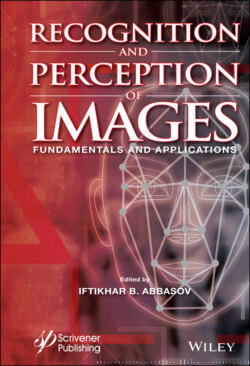Читать книгу Recognition and Perception of Images - Группа авторов - Страница 19
1.2.2 Visual Acuity
ОглавлениеVisual acuity refers to the ability to recognize small parts. There are five main types of acuity: detection, localization, resolution, recognition and dynamic acuity. The detection acuity is characterized by the detection of an object in the field of view. It is usually necessary to detect a small object of a certain size against a darker background. The acuteness of localization lies in the ability to distinguish between two lines, the ends of which are in contact with each other, as one single solid line (Figure 1.2.2, left). The sharpness of the resolving power of the eye is the ability to perceive the boundary between discrete elements (Figure 1.2.2, right); as it approaches the visual stimuli merge into one.
Figure 1.2.1 Human oculomotor muscles.
Testing the sharpness of resolution is usually performed using Landolt rings (Figure 1.2.3, right). To determine the acuity of recognition, a letter-based test is used, known to us as the Snellen table, which we encounter in an office of an optometrist (Figure 1.2.3, left). Dynamic acuity is determined by the ability to detect a moving stimulus and track its movement. With increasing speed of movement of the visual stimulus, it decreases.
The process of recognition of a visual stimulus depends on the size of the stimulus and on the distance to it. These two parameters are determined by the concept of the angle of view, the angle of view is the magnitude of the projection of the stimulus on the retina. The angle of view is measured in degrees; you can also use another subjective parameter – the rule of thumb. The width of the thumb of average size at arm’s length has the value of the angle of view of the order of 2°. Using this rule, it is quite easy to determine the approximate angles of view of objects that have been removed; for example, the moon or the sun make an angle of about 0.5°.
Figure 1.2.2 Determination of the sharpness of the resolution of the eye.
Figure 1.2.3 Snellen table and Landolt rings.
Figure 1.2.4 The stylized Landolt rings without the noise and with different noise level [Eremina, Shelepin, 2015].
The work of [Eremina, Shelepin, 2015] is dedicated to the study of visual perception by patients after cardiosurgical operations. The article describes the results of research of visual perception peculiarities and cognitive processing of visual images by the patients with ischemic heart disease. One hundred and seven middle-aged patients (62 years old) took part in the study. It was demonstrated that the capability to recognize the fragmented images declined immediately after the surgery (exemplified by Landolt rings, Figure 1.2.4). However, such capability is not only recovered but also surpasses the pre-surgical level in three months. Moreover, the patients undergoing surgery cope better with the offered tasks in three months after the surgery than patients getting non-surgical treatment.
